Compare with April 2012 pictures above.
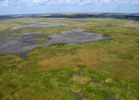
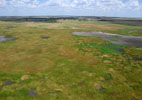
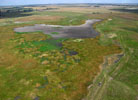
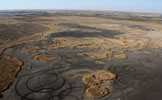
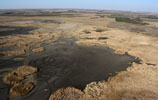

|

| Narrow, sinuous paths are cattle trails cutting through cattail thickets. Looping vehicle tracks on mudflat were made by local youth riding ATVs (four-wheelers). |  |
Return to beginning.
 |
| Panoramic overview looking northward at scene center. Small puddles are scattered in the marsh, and green emergent vegetation is sparse. Assembled from two overlapping photos. |
The 2011-13 drought came to an abrupt end with heavy rains and regional flooding beginning in late July through mid-August. TNC marshes were inundated with high water that recharged soil moisture and filled the pools. Kite aerial photography was conducted on September 6, about three weeks after peak flooding, under extremely hot conditions (99 °F) to document the effects of flooding and post-flood recovery.
Return to Cheyenne Bottoms homepage.

The gauging station on Walnut Creek at Albert, approximately 15 miles (24 km) west of Cheyenne Bottoms, is typical of central Kansas flooding. Peak discharge exceeded 460 cubic feet per second on August 12. Chart obtained from USGS.

Left: A – water smartweed (Lahring 2003), also known as water knotweed (Polygonum amphibium L.), B – great bulrush, and C – blunt spike rush. Right: A – mosquito fern (Azolla sp.) and B – lesser duckweed (Lemna minor).


Left: A – water speedwell (Veronica anagallis-aquatica L.) and B – algae.
Right: close-up shot of water smartweed, mosquito fern, duckweed, and algae along the marsh margin.


Spiny cocklebur (Xanthium spinosum L.) is a particularly nasty weed that flourished around the marsh margin during the drought. The seed pods now have opened to disperse a multitude of seeds to blow in the wind.


Left: limit of high water is marked by flood-washed debris, known as wrack (silent w), consisting mainly of bulrush and cattail fragments. Note lush, green wet meadow in background. Right: Close-up view of wrack with numerous crayfish and snail shells.

![]()
![]() Return to beginning.
Return to beginning.
Continue to 2014 – 2017.
All rights reserved © (2020).